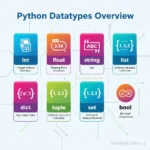Imagine you’ve got that one friend who refuses to change their opinion no matter what—whether it’s about pineapple on pizza 🍍🍕 or their undying love for 90’s Wi-Fi dial-up sounds. That’s exactly what tuples in Python are like: stubbornly immutable.
While your lists are the flexible, bendy types that keep changing outfits every 5 minutes, tuples are that classy cousin who locks their wardrobe and says, “Nope, I’m fine the way I am.”
If you’re still squinting at your screen going “Wait, what even is a tuple?”—don’t worry. Grab your coffee ☕, because we’re about to roast, explain, and celebrate this Python data type in one hilarious but educational ride.
What is a Tuple in Python?
A tuple in Python is basically a container that can hold multiple items—just like lists—but with one catch: you can’t change them once created.
Think of a tuple like a wedding photo. Once it’s taken, you can’t just swap Uncle Bob out for Elon Musk (as much as you might want to).
Syntax Example:
my_tuple = (1, "Python", 3.14)1→ Integer"Python"→ String3.14→ Float
Boom, all inside one tuple. It’s like the Avengers of data types—different heroes, one team.
👉 If you’re still new to Python basics, check out our Python data types overview to see where tuples fit in.
Why Use Tuples?
So, why bother with these immovable objects when lists already exist? Here’s why tuples rock:
- Immutable = Data safety. Perfect for “don’t-touch-this” data.
- Faster than lists (because immutability means Python optimizes storage).
- Hashable = Tuples can be used as dictionary keys. Lists? Nope.
- Lightweight = Tuples take less memory compared to lists.
Real-world analogy: Think of lists as your messy bedroom 🛏️ (you can rearrange stuff endlessly), and tuples as a framed museum exhibit 🎨 (you look, you admire, you don’t mess with it).
Python Tuple vs List
This is the Kardashian-level drama in Python households: tuples vs lists.
| Feature | List | Tuple |
|---|---|---|
| Mutability | ✅ Can change | ❌ Immutable |
| Performance | Slower | Faster |
| Syntax | [] | () |
| Hashable | No | Yes |
| Use Case | Dynamic data | Fixed data |
👉 If you want to dive deeper into list shenanigans, check out our Python lists tutorial.
Creating Tuples (Yes, Even Single Ones!)
The funniest thing about tuples? A single-element tuple needs a comma. Without it, Python thinks it’s just a lonely variable.
lonely = (42) # Not a tuple, just an int
real_tuple = (42,) # Now it’s a tuplePython: “Comma = Commitment.”
Accessing Tuple Elements
Just like lists, you can index and slice tuples:
fruits = ("apple", "banana", "cherry")
print(fruits[0]) # apple
print(fruits[-1]) # cherry
print(fruits[0:2]) # ('apple', 'banana')Slicing is basically like Netflix previews—you only see part of the full movie.
Tuple Operations (Count, Index & More)
Tuples don’t have as many flashy methods as lists, but they still come with some essentials:
numbers = (1, 2, 3, 2, 4, 2)
print(numbers.count(2)) # 3 times
print(numbers.index(4)) # index = 4th positionLimited methods, but hey, at least tuples don’t ghost you when you need them.
👉 For a deep dive into other data-type operations, check Python numbers explained.
Tuple Packing & Unpacking
One of the coolest tuple tricks is packing and unpacking:
# Packing
person = ("Alice", 25, "Engineer")
# Unpacking
name, age, job = person
print(name) # Alice
print(age) # 25It’s like wrapping three gifts 🎁 in one box, and then handing them out individually.
Nested Tuples (Tuples Inside Tuples)
Yes, tuples can hold other tuples, like a Russian doll 🪆.
nested = (1, (2, 3), (4, 5, 6))
print(nested[1][1]) # 3That’s tupleception right there.
Real-Life Use Cases of Tuples
Okay, enough theory. Why should you care about tuples?
- Coordinates & Geometry →
(x, y)points - Database Records →
(id, name, age)rows - Settings & Configs → Fixed constants that shouldn’t change
- Dictionary Keys → Because tuples are hashable
👉 Want to see how tuples fit in with other Python collections? Read Python collection types: lists, tuples, sets, dictionaries.
Common FAQs About Tuples
Can you change elements in a tuple?
Nope. Tuples are the “set-in-stone” type. If you need changes, use a list.
Why use tuple instead of list?
Performance, immutability, and hashability. Tuples shine where stability matters.
Can tuples hold mixed data?
Absolutely. A tuple doesn’t judge—it can hold strings, numbers, even other tuples.
How to create an empty tuple?
empty = ()
Final Thoughts
In a world of mutable chaos (lists, dictionaries, you name it), tuples are the calm, collected, unchanging monks 🧘 of Python.
They don’t flex too many methods, they don’t crave attention, but when you need them—boom—they’re reliable, fast, and classy.
So next time you’re coding, ask yourself:
👉 “Do I need a flexible shopping cart (list) or a locked museum exhibit (tuple)?”
If it’s the latter, congratulations—you just unlocked the true power of tuples.
And hey, if you’re just starting out, don’t miss our Learn Python for beginners guide to build a strong foundation.
Pro Tip: Tuples may not be flashy, but pair them with other Python built-in functions and they’ll surprise you.




